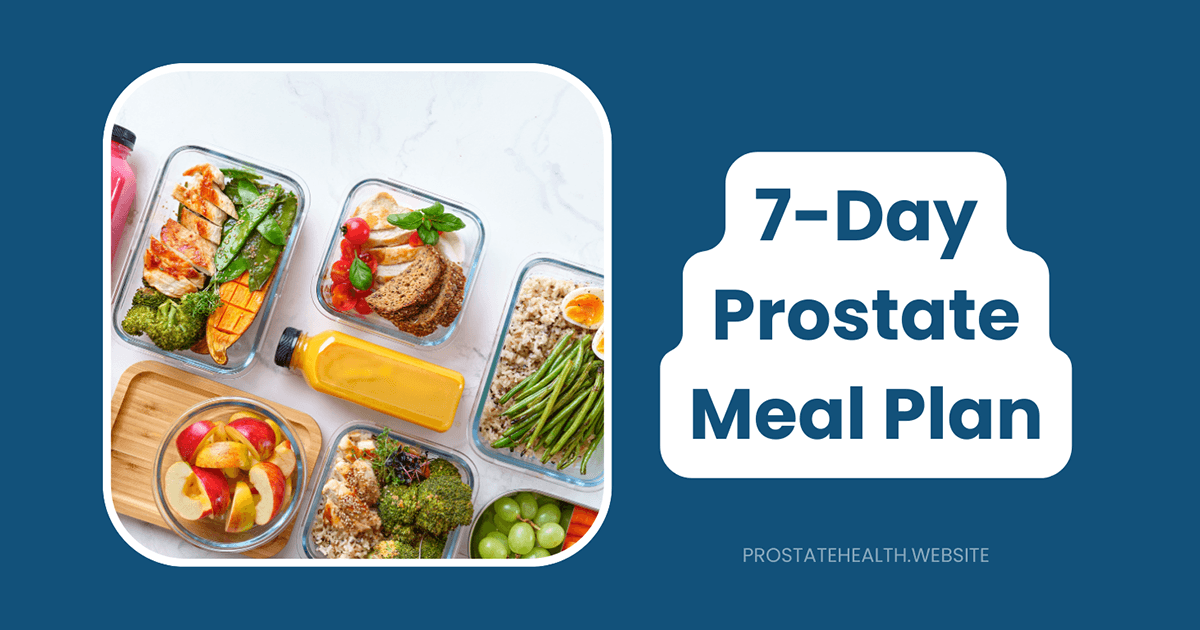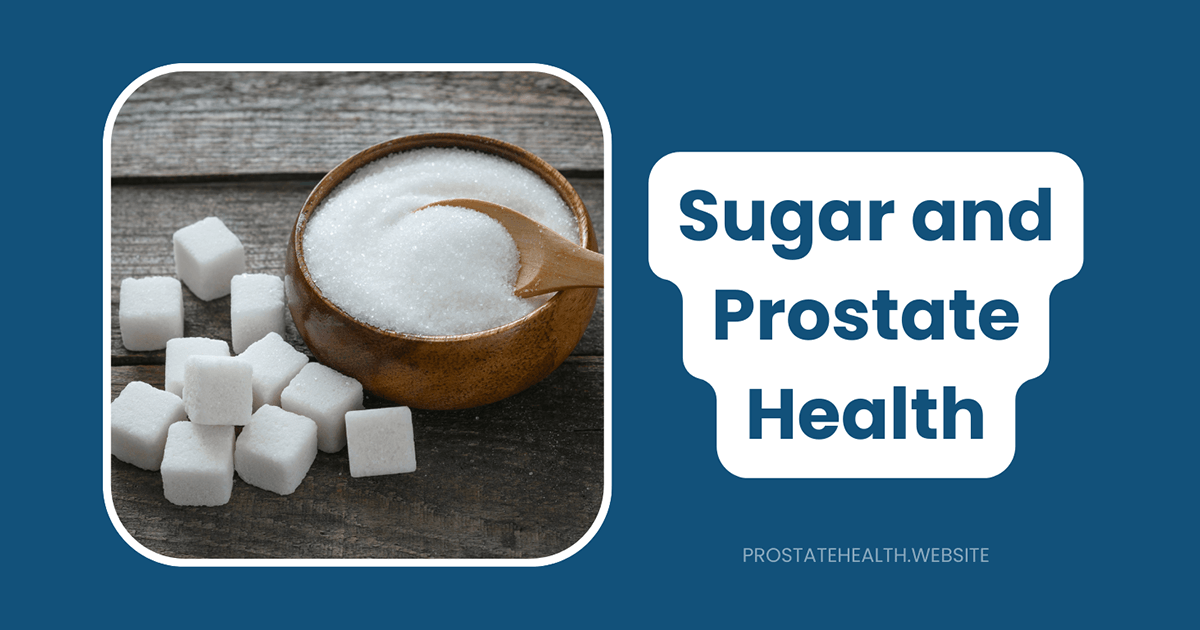Meal Planning for Optimal Prostate Health: A Weekly Guide

When Michael, a 62-year-old retired teacher, received a slightly elevated PSA reading at his annual checkup, his doctor suggested dietary changes as part of a proactive approach to prostate health.
“I knew I should be eating better,” Michael told me, “but I had no idea where to start. There’s so much information out there, and I needed something practical—a real plan I could follow.”
Michael’s experience is common. Many men understand that diet plays a crucial role in prostate health, but translating that knowledge into daily meals can be challenging. Whether you’re concerned about benign prostatic hyperplasia (BPH), prostatitis, or prostate cancer prevention, what you eat matters.
This comprehensive weekly meal plan is designed to take the guesswork out of eating for optimal prostate health. Based on the latest research and nutritional science, it provides a practical roadmap to nourishing your prostate—and your entire body—with delicious, easy-to-prepare meals.
The Science Behind Prostate-Healthy Eating
Before diving into meal plans, let’s understand which foods and nutrients support prostate health and why.
Key Nutrients for Prostate Health
1. Lycopene
This powerful antioxidant found primarily in tomatoes (especially cooked tomatoes) has been associated with reduced prostate cancer risk in multiple studies.
2. Omega-3 Fatty Acids
Found in fatty fish, flaxseeds, and walnuts, these essential fats help combat inflammation, which is linked to prostate conditions.
3. Selenium
This mineral, abundant in Brazil nuts, seafood, and whole grains, supports prostate health through its antioxidant properties.
4. Zinc
The prostate contains more zinc than any other organ in the body. Good sources include pumpkin seeds, oysters, and legumes.
5. Vitamin D
Low vitamin D levels have been associated with increased prostate cancer risk. While sunlight is a primary source, fatty fish and fortified foods also provide this vital nutrient.
6. Polyphenols
These plant compounds found in green tea, berries, and colorful vegetables have anti-inflammatory and antioxidant properties beneficial for prostate health.
Foods to Emphasize
Research consistently shows that certain dietary patterns, particularly the Mediterranean diet, support prostate health. Key components include:
- Colorful vegetables and fruits: Aim for 7-9 servings daily
- Cruciferous vegetables: Broccoli, cauliflower, Brussels sprouts, and kale contain compounds that may help prevent prostate cancer
- Tomatoes and tomato products: Rich in lycopene, especially when cooked with olive oil
- Fatty fish: Salmon, sardines, mackerel (2-3 servings weekly)
- Legumes: Beans, lentils, and chickpeas provide plant protein and fiber
- Whole grains: Brown rice, quinoa, oats, and whole wheat products
- Nuts and seeds: Especially walnuts, flaxseeds, and pumpkin seeds
- Healthy oils: Primarily extra virgin olive oil
- Green tea: Contains catechins that may benefit prostate health
- Herbs and spices: Particularly turmeric, which contains curcumin
Foods to Limit
Just as important as what to eat is what to minimize:
- Red and processed meats: Limit to once weekly or less
- Dairy products: Some studies suggest high dairy consumption may increase prostate cancer risk
- Sugar and refined carbohydrates: Associated with inflammation and potentially increased cancer risk
- Alcohol: If consumed, limit to moderate amounts
- Highly processed foods: Generally high in unhealthy fats, sugar, and salt
Dr. Sarah Johnson, nutritional oncologist at Memorial Cancer Center, explains: “The ideal prostate-healthy diet isn’t about a single superfood or nutrient. It’s about an overall pattern of eating that reduces inflammation, provides antioxidant protection, and supports hormonal balance—all factors that influence prostate health.”
Your Weekly Meal Plan for Optimal Prostate Health
This 7-day plan incorporates the principles above into delicious, practical meals. Each day provides approximately 2,000 calories, which can be adjusted based on your individual needs.
Monday
Breakfast:
- Overnight oats with ground flaxseeds, blueberries, and walnuts (1/2 cup oats, 1 tbsp flaxseeds, 1/4 cup blueberries, 1 tbsp chopped walnuts, 3/4 cup unsweetened almond milk)
- Green tea
Lunch:
- Mediterranean Chickpea Salad: 1 cup chickpeas, cherry tomatoes, cucumber, red onion, olives, and feta with olive oil and lemon dressing
- 1 medium apple
Dinner:
- Baked salmon (4 oz) with garlic and herbs
- Roasted Brussels sprouts and sweet potatoes (1 cup total)
- Quinoa (1/2 cup cooked)
- Mixed green salad with olive oil and balsamic vinegar
Snack:
- 1/4 cup pumpkin seeds
- 1 small orange
Tuesday
Breakfast:
- Vegetable omelet (2 eggs with spinach, tomatoes, and mushrooms)
- 1 slice whole grain toast with 1/4 avocado
- Green tea
Lunch:
- Lentil soup (1 cup)
- Mixed green salad with olive oil and lemon juice
- 1 small whole grain roll
Dinner:
- Stir-fried tofu (4 oz) with broccoli, bell peppers, and snap peas
- Brown rice (1/2 cup cooked)
- Sliced tomatoes with olive oil and basil
Snack:
- Greek yogurt (3/4 cup) with berries (1/2 cup)
Wednesday
Breakfast:
- Smoothie: 1 cup spinach, 1 small banana, 1 tbsp ground flaxseeds, 1 tbsp almond butter, 3/4 cup unsweetened almond milk, ice
- 1 slice whole grain toast
Lunch:
- Turkey and avocado wrap with whole grain tortilla, 3 oz turkey, 1/4 avocado, lettuce, tomato
- Carrot and celery sticks with hummus (2 tbsp)
Dinner:
- Grilled chicken breast (4 oz) with rosemary and lemon
- Ratatouille (1 cup of eggplant, zucchini, bell peppers, and tomatoes cooked in olive oil)
- Farro (1/2 cup cooked)
Snack:
- 1 medium pear
- 10 almonds
Thursday
Breakfast:
- Steel-cut oatmeal (1/2 cup dry) with cinnamon, 1 tbsp ground flaxseeds, and 1 small diced apple
- Green tea
Lunch:
- Tuna salad made with olive oil (3 oz tuna) on bed of mixed greens with cherry tomatoes, cucumber, and red onion
- 1 small whole grain roll
Dinner:
- Tomato and Lentil Soup: Rich in lycopene and plant protein (1.5 cups)
- Mixed green salad with olive oil and balsamic vinegar
- 1 slice whole grain bread
Snack:
- 1/4 cup mixed berries
- 1 oz dark chocolate (70% or higher cacao)
Friday
Breakfast:
- Whole grain toast (2 slices) with 1/2 avocado and sliced tomato
- 1 kiwi fruit
- Green tea
Lunch:
- Quinoa bowl with roasted vegetables (1/2 cup quinoa, 1 cup roasted vegetables), 2 tbsp pumpkin seeds, and tahini dressing
- 1 medium orange
Dinner:
- Baked cod (4 oz) with herbs and lemon
- Sautéed kale with garlic (1 cup)
- Sweet potato (1 medium)
Snack:
- 1 small banana with 1 tbsp almond butter
Saturday
Breakfast:
- Vegetable frittata with 2 eggs, spinach, tomatoes, and onions
- 1/2 grapefruit
- Green tea
Lunch:
- Mediterranean plate: 1/4 cup hummus, 1/2 cup tabbouleh, olives, cucumber slices, cherry tomatoes, 1 whole wheat pita
- 1 medium peach
Dinner:
- Grilled vegetable and chicken kebabs (4 oz chicken, 1 cup vegetables including bell peppers, onions, zucchini, and cherry tomatoes)
- Brown rice pilaf with herbs (1/2 cup)
- Mixed green salad with olive oil and lemon juice
Snack:
- 3/4 cup berries
- 2 Brazil nuts (for selenium)
Sunday
Breakfast:
- Whole grain pancakes (2 small) topped with 1/2 cup mixed berries
- 1 tbsp ground flaxseeds mixed into pancake batter
- Green tea
Lunch:
- Bean and vegetable soup (1.5 cups)
- 1 slice whole grain bread with olive oil
- 1 medium apple
Dinner:
- Tomato and Herb Baked Salmon (4 oz)
- Roasted cauliflower and broccoli (1 cup)
- Quinoa (1/2 cup cooked)
- Mixed green salad with olive oil and balsamic vinegar
Snack:
- 1/4 cup walnuts
- 1 small orange
Shopping List
Produce
- Spinach (2 bags)
- Mixed salad greens (1 large container)
- Kale (1 bunch)
- Broccoli (1 large head)
- Cauliflower (1 head)
- Brussels sprouts (1 lb)
- Bell peppers (red, yellow, green – 4 total)
- Zucchini (2)
- Eggplant (1)
- Sweet potatoes (3)
- Tomatoes (6 medium)
- Cherry tomatoes (1 pint)
- Cucumber (2)
- Carrots (1 bunch)
- Celery (1 bunch)
- Red onions (2)
- Yellow onions (2)
- Garlic (1 head)
- Ginger root (small piece)
- Avocados (2)
- Lemons (3)
- Limes (2)
- Apples (4)
- Bananas (3)
- Oranges (3)
- Grapefruit (1)
- Pear (1)
- Peach (1)
- Kiwi (1)
- Berries (2 containers mixed)
- Fresh herbs: basil, rosemary, thyme, parsley
Proteins
- Salmon fillets (8 oz)
- Cod fillets (4 oz)
- Chicken breasts (8 oz)
- Turkey breast (sliced, 6 oz)
- Tofu (extra firm, 1 block)
- Eggs (1 dozen)
- Canned tuna (in water, 1 can)
- Greek yogurt (1 container)
Grains and Legumes
- Steel-cut oats
- Rolled oats
- Quinoa
- Brown rice
- Farro
- Whole grain bread
- Whole grain tortillas
- Whole wheat pita
- Lentils (green or brown)
- Chickpeas (1 can and dry)
- Black beans (1 can)
- Cannellini beans (1 can)
Nuts, Seeds, and Oils
- Walnuts
- Almonds
- Brazil nuts
- Pumpkin seeds
- Flaxseeds (ground)
- Extra virgin olive oil
- Tahini
Other Items
- Green tea
- Almond milk (unsweetened)
- Almond butter
- Hummus (or ingredients to make it)
- Feta cheese (small amount)
- Olives
- Balsamic vinegar
- Low-sodium vegetable broth
- Canned diced tomatoes
- Tomato paste
- Dark chocolate (70%+ cacao)
- Spices: turmeric, cinnamon, cumin, paprika, black pepper
Meal Prep Tips for Success
Preparing prostate-healthy meals is easier with some advance planning:
Weekend Prep (1-2 hours)
- Wash and chop vegetables: Store in glass containers for easy access
- Cook grains: Prepare brown rice, quinoa, and farro to use throughout the week
- Make soup or stew: Prepare the lentil soup or bean soup for lunches
- Prepare overnight oats: Make several jars for quick breakfasts
- Toast nuts and seeds: Enhances flavor and makes them ready to use
Batch Cooking Ideas
- Roast a large tray of mixed vegetables to use in various meals
- Cook extra chicken or fish to repurpose in salads and wraps
- Prepare a large pot of soup that can be portioned and frozen
Time-Saving Shortcuts
- Use pre-washed salad greens
- Consider frozen vegetables when fresh aren’t available
- Keep canned beans and fish on hand for quick protein options
- Use a slow cooker or Instant Pot for hands-off cooking
Adapting the Plan for Specific Prostate Conditions
While this meal plan supports general prostate health, specific conditions may benefit from additional modifications:
For BPH (Enlarged Prostate)
- Further limit caffeine: Consider herbal teas instead of green tea
- Reduce evening fluids: To minimize nighttime urination
- Emphasize pumpkin seeds: Contains compounds that may help reduce BPH symptoms
- Consider saw palmetto: Discuss with your healthcare provider about incorporating this herb
For Prostatitis
- Increase anti-inflammatory foods: Even more emphasis on omega-3 rich foods and turmeric
- Stay well-hydrated: Throughout the day (but reduce evening fluids)
- Consider eliminating potential trigger foods: Some men find that spicy foods, alcohol, or caffeine worsen symptoms
During Prostate Cancer Treatment
- Increase protein: May need 1-1.5g per kg of body weight during treatment
- Focus on easy-to-digest foods: If experiencing digestive issues
- Emphasize calorie-dense foods: If maintaining weight is challenging
- Work with a dietitian: For personalized recommendations based on your specific treatment
Dr. Michael Chen, urologic oncologist, notes: “Nutrition needs can vary significantly during cancer treatment. What works during one phase may need adjustment during another. Regular communication with your healthcare team about dietary challenges is essential.”
Real-World Success: A Patient’s Perspective
Remember Michael from the beginning of our article? Six months after adopting a prostate-healthy eating plan similar to this one, he shared his experience:
“The structure of a weekly meal plan made all the difference for me. Instead of feeling overwhelmed by a list of foods to eat or avoid, I had actual meals to prepare. My PSA has stabilized, I’ve lost 12 pounds without trying, and I have more energy than I’ve had in years. Plus, my wife loves the meals too—we’re both eating better now.”
Michael’s experience highlights an important point: the benefits of prostate-healthy eating extend beyond the prostate. The anti-inflammatory, nutrient-dense foods in this plan support overall health, potentially reducing risk for heart disease, diabetes, and other conditions.
Beyond the Meal Plan: Other Factors for Prostate Health
While nutrition is crucial, other lifestyle factors also influence prostate health:
Physical Activity
Aim for at least 150 minutes of moderate exercise weekly, plus strength training twice weekly. Exercise helps maintain healthy weight, reduce inflammation, and may directly benefit prostate health.
Stress Management
Chronic stress can worsen inflammation. Consider practices like meditation, deep breathing, or yoga to manage stress levels.
Adequate Sleep
Poor sleep is linked to increased inflammation. Aim for 7-8 hours of quality sleep nightly.
Staying Hydrated
Proper hydration supports overall prostate function. Aim for 8-10 cups of fluid daily, primarily water.
Regular Medical Check-ups
Follow your healthcare provider’s recommendations for prostate screenings and check-ups.
Conclusion: Consistency is Key
The most effective meal plan is one you can maintain consistently. This weekly guide provides a framework, but feel free to adapt it to your preferences, cultural background, and lifestyle.
Dr. Jennifer Williams, integrative medicine specialist, advises: “Small, sustainable changes often yield better long-term results than dramatic dietary overhauls that prove difficult to maintain. Start by incorporating one or two prostate-healthy meals per day, then gradually expand from there.”
Remember that dietary changes take time to show their full benefits. Be patient with yourself and celebrate small victories along the way. Your prostate—and your entire body—will thank you for the nourishing foods you provide.






